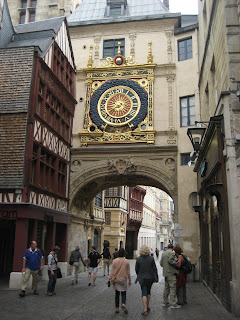 |
| The Seine in Rouen and the Cathedral |
June 4-6 - Brussels to Rouen, France
Meredith was at our hotel promptly at 10:45 a.m. And after a little hassle with the Europcar reservation, we were on our way from Brussels to Rouen.
We got to our hotel in Rouen after an easy four hour drive. Finding the hotel proved to be the most challenging since we didn’t have a local map of Rouen. A friendly taxi driver helped us out.
Rouen is one of the oldest cities in Normandy, dating back to 50B.C.! Built along the Seine, it has dramatic soaring spires and a number of ancient half-timber buildings that often lean or bulge in the middle. The Romans and the Vikings were here as were the Brits. When walking through the narrow cobblestone streets, one can well imagine a time when Joan of Arc wandered through them. At the end of one of the streets is where the English burned the 19 year old alive at the stake.
One of the more dramatic sights in Rouen is the Notre Dame Cathedral. Of Gothic design, the cathedral’s spire reach an amazing 151 meters into the air and can be seen from all around town. The cathedral took over three hundred years to build, having been started in 1201 and suffered much destruction a several times. Luckily for us, it was always rebuilt.
 |
| Half timber buildings |
We had a grand time walking through all the narrow, medieval streets. By the end of the day, we all felt like we knew the geography of the city quite well. And that only meant one thing - it was time to move onward!
June 7 - Honfleur, Aromanches and D-Day Beaches
 |
| Honfleur Harbor |
The next day we were off to the Normandy Coast beaches. It took us a couple of tries to get out of Rouen, but we eventually made it out of the city in the right direction.
Our first stop was Honfleur, a very picturesque harbor town at the mouth of the Seine River that dates back a thousand years. For several centuries, up until the 1400’s it was even ruled by the English. Even though in years past it may have been the home of explorers, pirates, merchants and fishermen, today it seems mostly a tourist town, still very quaint, but one mostly centered on restaurants and gift shops. We moved on after a lunch stop at one of the many restaurants along the quay.
 |
| Honfleur |
From Honfleur we drove past a number of coastal villages and then D-Day landing areas such as Gold Beach and Juno Beach. After a couple of hours of driving we arrived at our hotel (Hotel Le Chanteclair), in Aromanches, one of the villages in an area known as Omaha Beach, where the U.S. forces landed in WWII. Right down the street from us you can see the remnants of the Mulberies - concrete docks used by the Allied forces that they had floated over from England. They sank the docks right off shore, which then enabled them to bring in the supplies needed for the Normandy invasion back in June 1944.
 |
| Omaha Beach |
Although there is much more to see here, the one day we were here, we managed to see the Normandy American Military Cemetery and Memorial (and a great museum); Pointe du Hoc, the place where U.S. Army Rangers scaled up cliffs to overtake German defensive positions and is now a memorial; several of the German bunkers and gunnery emplacements that line the shores; the Batterie de Longues, which are the massive (152mm) German artillery guns that were capable of shooting a distance of up to 14 miles; on a lark, we decided to stop and see the German soldier’s cemetery, something we had not expected to see here. Germany actually maintains a number of cemeteries for their fallen soldiers.
 |
| A piece of the Mulberry docks |
 |
| U.S. Cemetery |
 |
| A view out of the German bunker |
 |
| One of the 152mm guns |
After visiting the WWII sights, we made a brief stop to the town of Bayeux, one of the few places to be spared from the bombing in the war, thus still having many of the old buildings and a beautiful cathedral.






No comments:
Post a Comment